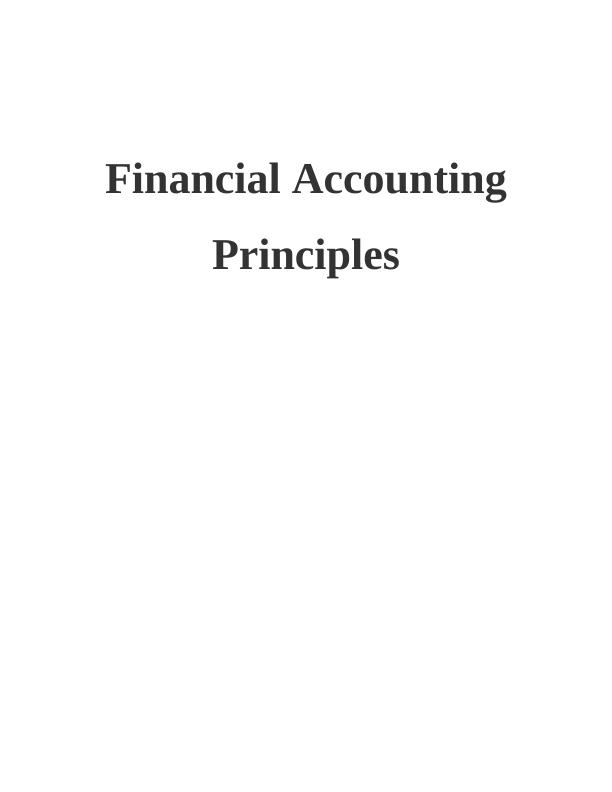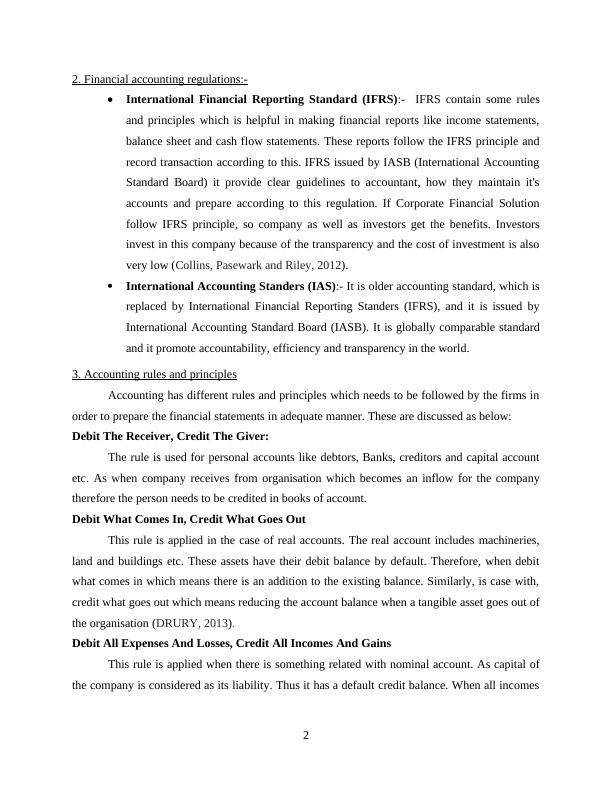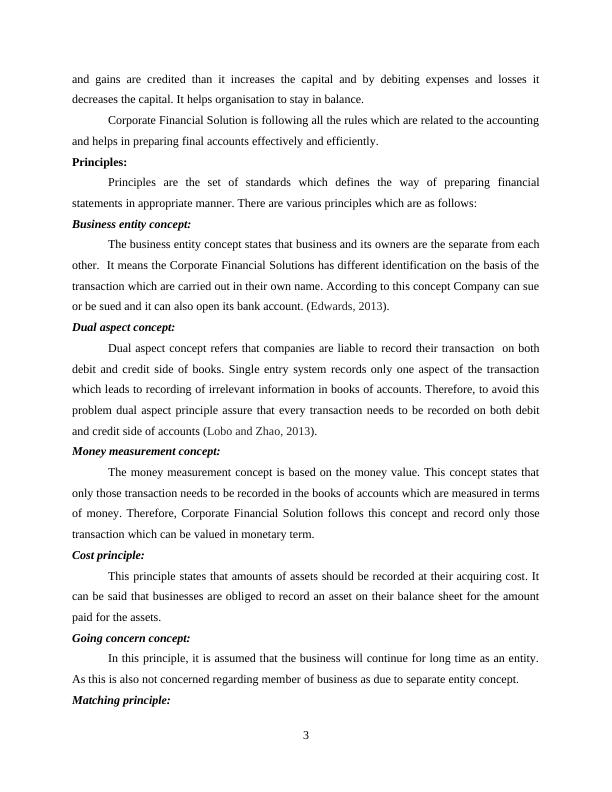Financial Accounting Principles INTRODUCTION
Added on 2020-10-22
27 Pages6810 Words416 Views
Financial AccountingPrinciples

Table of ContentsINTRODUCTION...........................................................................................................................11. Financial accounting and its purpose.......................................................................................12. Financial accounting regulations:-...........................................................................................23. Accounting rules and principles...............................................................................................24. Conventions and concepts related to consistency and material disclosure..............................4CLIENT 1........................................................................................................................................41. Journal entry in books of David Study....................................................................................42. Ledger Account........................................................................................................................73. Trial Balance as on 31st January 2018..................................................................................13CLIENT 2......................................................................................................................................14A. Statement of profit and loss for Peter Hampau for year ended 31st July 2018.....................14B. Statement of financial position for Peter Hampau for year ended on 31st July 2018...........15CLIENT 3......................................................................................................................................16A. Profit and loss account..........................................................................................................16B. Balance Sheet........................................................................................................................17C. Consistency and Prudence concepts......................................................................................18D. Depreciation and its methods................................................................................................18CLIENT 4......................................................................................................................................19A. Purpose of BRS to CEO of Durrell.......................................................................................19B. Prepare Durrell Ltd's updated cash book for December 2017..............................................19C. Bank Reconciliation Statement.............................................................................................20CLIENT 5......................................................................................................................................20A. Ledger control accounts........................................................................................................20B. Control account.....................................................................................................................21CLIENT 6......................................................................................................................................21A. Suspense Account.................................................................................................................21B. Drafting of Trial Balance......................................................................................................22C. Journal entry for suspense account........................................................................................22D. Difference between suspense a/c and clearing a/c................................................................23


INTRODUCTIONFinancial accounting principle assist an organisation to prepare their financial statementsin an adequate manner so that management can use these statements for making better decisions.Financial accounting is the process of recording, summarizing and reporting the entries andtransactions in final accounts like Income statement and Balance sheet. These statements areprepared on the basis of pre set standards which are followed by every organisation. With thehelp of these statements of accounts one can come to know regarding the actual position andperformance of company in front of its stakeholders.The main aim of this report is to ensure firm follows the rules and principles ofaccountancy. To better understand this concept, Corporate Financial Solutions (CFS), London isbeing selected for this present report. The financial accounting, its purposes, rules and principlesand regulations related to financial accounting is being discussed in this report. Apart from this,there are various concepts such as conventions, consistency and material disclosure concept isalso explained in this project. Beside this, trial balance, sole trader, Bank Reconciliationstatements are prepared in this report.1. Financial accounting and its purposeFinancial accounting: - It is a process of preparing financial statements that are helpfulin identifying financial performance and position of companies. These statements are useful forinternal as well as for external analysis. Outside parties such as investors, supplier, creditor orcustomers. It is a specialized branch of accounting which continuously keep eyes on company’stransactions and with the help of these transaction company tend to prepare financial report suchas income statement, balance sheet or cash flow statement.Purpose of financial accounting: - Main purpose of financial accounting is to provide accurate information that play amajor role in decision making.Prepare financial report would show financial position of Corporate FinancialSolution that tend to provide information to external users such as creditors, potentialinvestors, suppliers and tax authorities.1

2. Financial accounting regulations:-International Financial Reporting Standard (IFRS):- IFRS contain some rulesand principles which is helpful in making financial reports like income statements,balance sheet and cash flow statements. These reports follow the IFRS principle andrecord transaction according to this. IFRS issued by IASB (International AccountingStandard Board) it provide clear guidelines to accountant, how they maintain it'saccounts and prepare according to this regulation. If Corporate Financial Solutionfollow IFRS principle, so company as well as investors get the benefits. Investorsinvest in this company because of the transparency and the cost of investment is alsovery low (Collins, Pasewark and Riley, 2012). International Accounting Standers (IAS):- It is older accounting standard, which isreplaced by International Financial Reporting Standers (IFRS), and it is issued byInternational Accounting Standard Board (IASB). It is globally comparable standardand it promote accountability, efficiency and transparency in the world.3. Accounting rules and principlesAccounting has different rules and principles which needs to be followed by the firms inorder to prepare the financial statements in adequate manner. These are discussed as below:Debit The Receiver, Credit The Giver:The rule is used for personal accounts like debtors, Banks, creditors and capital accountetc. As when company receives from organisation which becomes an inflow for the companytherefore the person needs to be credited in books of account. Debit What Comes In, Credit What Goes OutThis rule is applied in the case of real accounts. The real account includes machineries,land and buildings etc. These assets have their debit balance by default. Therefore, when debitwhat comes in which means there is an addition to the existing balance. Similarly, is case with,credit what goes out which means reducing the account balance when a tangible asset goes out ofthe organisation (DRURY, 2013). Debit All Expenses And Losses, Credit All Incomes And GainsThis rule is applied when there is something related with nominal account. As capital ofthe company is considered as its liability. Thus it has a default credit balance. When all incomes2

and gains are credited than it increases the capital and by debiting expenses and losses itdecreases the capital. It helps organisation to stay in balance. Corporate Financial Solution is following all the rules which are related to the accountingand helps in preparing final accounts effectively and efficiently. Principles:Principles are the set of standards which defines the way of preparing financialstatements in appropriate manner. There are various principles which are as follows:Business entity concept:The business entity concept states that business and its owners are the separate from eachother. It means the Corporate Financial Solutions has different identification on the basis of thetransaction which are carried out in their own name. According to this concept Company can sueor be sued and it can also open its bank account. (Edwards, 2013).Dual aspect concept:Dual aspect concept refers that companies are liable to record their transaction on bothdebit and credit side of books. Single entry system records only one aspect of the transactionwhich leads to recording of irrelevant information in books of accounts. Therefore, to avoid thisproblem dual aspect principle assure that every transaction needs to be recorded on both debitand credit side of accounts (Lobo and Zhao, 2013).Money measurement concept:The money measurement concept is based on the money value. This concept states thatonly those transaction needs to be recorded in the books of accounts which are measured in termsof money. Therefore, Corporate Financial Solution follows this concept and record only thosetransaction which can be valued in monetary term.Cost principle:This principle states that amounts of assets should be recorded at their acquiring cost. Itcan be said that businesses are obliged to record an asset on their balance sheet for the amountpaid for the assets.Going concern concept:In this principle, it is assumed that the business will continue for long time as an entity.As this is also not concerned regarding member of business as due to separate entity concept.Matching principle:3

End of preview
Want to access all the pages? Upload your documents or become a member.
Related Documents
Financial Accounting Assignment - Zync Solutionslg...
|29
|5360
|97
Financial Accounting Principles Assignment - RBS Accountants Ltdlg...
|26
|7021
|485
Introduction to Financial Accountinglg...
|30
|5105
|401
Financial Accounting Principles Assignment - Doclg...
|30
|7212
|286
Finance Accounting INTRODUCTION 4 BUSINESS RPORTlg...
|25
|7261
|384
1.Financial Accounting and its Purposeslg...
|27
|6999
|247
